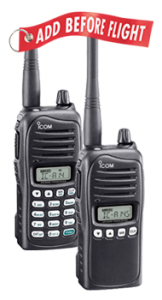 Pilot-controller radio communications is critical to the ATC (Air Traffic Control) system. Clear communications is key. Pilots must confirm each radio communication using the appropriate aircraft call signs. The controller must understand what the pilot wants done before carrying out control duties. Likewise, pilots must understand and acknowledge the controller’s instructions. Keep communications brief and do not use ATC slang. Review the pilot/controller glossary that is used in the ATC Controller’s handbook.
Pilot-controller radio communications is critical to the ATC (Air Traffic Control) system. Clear communications is key. Pilots must confirm each radio communication using the appropriate aircraft call signs. The controller must understand what the pilot wants done before carrying out control duties. Likewise, pilots must understand and acknowledge the controller’s instructions. Keep communications brief and do not use ATC slang. Review the pilot/controller glossary that is used in the ATC Controller’s handbook.
Check out the Federal Aviation Administration’s Glossary and Handbook online.
Basic Techniques
- Listen before transmitting.
- Think before keying your transmitter. Know what you want to say.
Write it down if it’s lengthy. - The mic should be positioned close to your lips. After pressing the PTT (push to talk) or mic button, take a slight pause before speaking to ensure that the first word is transmitted.
- Speak in a normal tone of voice.
- When you release the PTT button, wait a few seconds before calling again. The controller could be writing down your information, searching for your flight plan, transmitting on a different frequency etc.
- Be aware of sounds (or the lack of sounds) in your receiver. Check your volume, re-check your frequency, and be sure that your PTT or your mic button isn’t stuck in the transmit position. You don’t want frequency blockage to occur because of unintentional transmitter operation.
- Stay within the coverage range of your radio equipment and ground station equipment. Remember that higher altitude increases the range of VHF “line of sight” communications.
For more information, review the FAA Radio Communications Phraseology and Techniques
Icom’s A14 (full keypad) and the A14S (simple keypad) receive NAV and WX channels, and provide simpler operation with a minimum of buttons that is suitable for ground crews. Learn more about this compact, lightweight and easy to use radio online.

